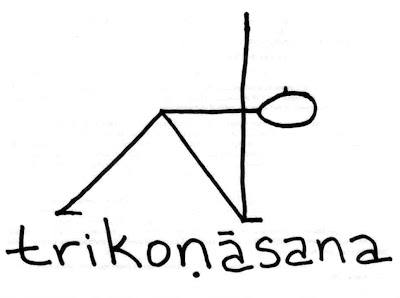 Triangle pose. Sometimes called utthita trikoṇāsana (extended triangle pose).
Triangle pose. Sometimes called utthita trikoṇāsana (extended triangle pose).“The triangle appears in many forms in the world….The qualities of a triangle are strength and the ability to support weight and resist pressure; and so the principle of the triangle is used extensively in the building industry. As you stand in Utthita Trikoṇasana, you might ask yourself how much you can support, and how well you can resist pressure.
“The tripod, used by photographers to steady the camera in order to get sharp pictures, is triangular in structure. When physical balance has been achieved in the practice of this asana, a sharper picture will emerge of the balance required in all areas of life….” [1]
Benefits: Tones the legs and strengthens the ankles; releases the hip joints as well as the groin and hamstrings; Releases the spine and spinal musculature; stretches and opens the sides of the body; opens the chest and shoulders; strengthens abdominal organs and improves digestion as it tones abdominals; aids in stress relief. [3]
Phonetic pronunciation: trih-koe-nah-suh-nuh [2]
Also, *ut-tih-tuh trih-koe-nah-suh-nuh (*u as in “put”)
utthita = extended or stretched
tri = Three
kona = Angle
āsana = Pose
Entering the Pose [3]
• From tāḍāsana (mountain pose), extend your arms out to your sides with your palms facing downward.
• Continue to focus on your breath.
• Move your legs apart while trying to bring your feet as far apart as your outstretched hands.
• Rotate the right leg out 90 degrees and then turn the left foot in slightly toward the right approximately 45 degrees. Imagine a straight line drawn back from your right heel. That line should pass through the middle of your left arch.
• Keep the front thigh muscles (quadriceps) active by gently drawing the kneecaps up.
• Imagine that your back is pressed against a wall. Work to keep the right leg rolling out (externally rotate). At the same time, keep your left hip from rolling forward by pressing it back toward the imaginary wall. This action opens the front pelvis. Keep your tailbone lengthened toward the floor.
• With your arms extending out as far as possible, exhale as you reach your right fingers out to the right side by extending your trunk from your left hip joint. Create more length in your torso by imagining your tailbone and right ribcage are moving farther apart from each other.
• Continue to focus on your breath.
• Feel the left side of your torso stretch so that your left shoulder and left hip move farther away from each other. Keep your left ribcage as parallel to the floor as possible.
• Work to keep your upper and lower body in the same plane. Continue to imagine you are standing against a wall with your left shoulder and hip rotating back.
• When you have reached as far to the right as you can comfortably, begin to lower your right hand toward the floor and reach your left fingertips toward the sky. Keep your upper and lower body in alignment.
• Feel the crown of your head reaching toward your right hand, creating as much length in your spine as possible.
• turn and look up toward your left fingers.
• Focus on balancing yourself equally over both feet as your work to keep your chest and pelvis open.
• Continue to focus on your breath.
To Come Out of the Pose [3]
Inhale and continue to press down through your legs as you bring your upper body into an upright standing position and prepare for the other side.
Cautions [3]
• Heart conditions, high blood pressure: Gaze downward
• Neck pain or injury: Continue to gaze forward without turning the neck
• Shoulder problems: Keep the top hand on the hip, and continue to rotate the shoulder back.
“…Three days of prayer, a triduum, sometimes precede spiritual occasions or practices in many religions, and include a fast or special celebrations to prepare oneself for the inner path.
“Jesus reminded his followers that where two or three are gathered together, there he would be also….
“To grow and nourish the trillium, the trinity lily, with its three large white petals, is to nourish the symbol of a pure heart, pure body and pure mind. Taking the three steps leading up to the tabernacle of the heart will allow love and compassion to flower.” [1]
Namasté,
Jonie
___________________________________________
[1] Swami Sivananda Radha, Hatha Yoga, The Hidden language: Symbols, Secrets & Metaphor (Timeless Books, 2007), pp. 79-81.
[2] Stick figure instructions, pronunciation, and translation provided by Mikelle Terson, Asana Learning Deck, http://www.yogablossom.com/
[3] Kathy Lee Kappmeier and Diane M. Ambrosini, Instructing Hatha Yoga, (Human Kinetics, 2006), pp. 81-84.
No comments:
Post a Comment